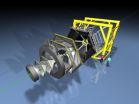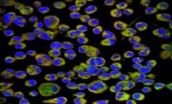(Press-News.org) Although Dark Energy and Dark Matter appear to constitute over 95 percent of the universe, nobody knows of which particles they are made up. Astrophysicists now crossed one potential Dark Matter candidate – the Dark Photon or U boson – off the list in top position. This is the result of recent HADES experiments, where researchers from the Helmholtz-Zentrum Dresden-Rossendorf (HZDR) and from 17 other European institutes try to pin down the nature of Dark Matter. These negative results – recently published in Physics Letters B – could even lead to challenges of the Standard Model of particle physics.
The interpretation of current astrophysical observations results in the striking mass-energy budget of matter in the universe: 75% Dark Energy and 20% Dark Matter. Only about 5% of the universe consists of "ordinary", baryonic matter.
Many attempts have been made to explain the nature of Dark Matter. Researchers believe that Dark Matter is comprised by hitherto unknown particles which do not fit into the Standard Model of particle physics. The Standard Model is a theoretically sound quantum field theory with fundamental matter particles, such as quarks (bound in hadrons, e.g., baryons) and leptons (e.g., electrons and neutrinos), which interact via exchange of force-carrier quanta, called gauge bosons (e.g., photons). Some of these species acquire their masses by the interaction with the Higgs boson. While evidences for the Higgs boson were found recently at CERN, the Standard Model looks now complete when supplemented by some neutrino masses, and nothing else seems to be needed to understand the wealth of atomic, sub-nuclear and particle physics phenomena. Nevertheless, Dark Matter appears not to be explained by any of the constituents of the Standard Model. This status of the affair has initiated worldwide efforts to search for Dark Matter candidates.
Beyond the Standard Model
Searching a needle in the haystack is simpler: one knows both the wanted object (the needle) and the place (the haystack). In the case of Dark Matter the object is unknown, and the localization, e.g. in galactic halos, is also not constraining the loci of interest. To specify the search goal one can envisage diverse hypothetical candidates, such as certain hypothetical particles beyond the Standard Model, which fulfill requirements qualifying them as constituents of Dark Matter.
Dark Energy drives the presently observed accelerated expansion of the universe. Dark Energy is homogeneously distributed and can be attributed to a cosmological constant or vacuum energy. In extreme cases it may cause, in the future, such a sudden expansion that anything in the universe is disrupted - this would be the Big Rip. Dark Matter, in contrast, is bumpy and is needed to explain the formation of the observed density distribution of visible matter in the evolving universe, evidenced by the hierarchy of structures from (super)clusters of galaxies, galaxies, stars, planets and other compact objects such as meteorites, etc.
Among the lists of candidates of Dark Matter is a hypothetical particle, often dubbed U boson or Dark Photon. These nicknames refer to the underlying theory construction: a second unitary ("U") symmetry allows for quanta which are, in one respect, similar to photons - namely gauge bosons - but in another respect different from photons - namely attributing to these quanta a mass, making them to Dark Photons because of a very weak interaction with normal matter. Very similar to photons the Dark Photons can decay into electron-positron pairs, if they have the proper virtuality. Combining the chain of hypotheses one arrives at a scenario, where an "ordinary" virtual photon converts into a Dark Photon which decays afterwards into an electron-positron pair.
Needle and Haystack
If a Dark Photon or U boson would exist with the assumed properties mentioned above and would have a mass, a certain width and a certain coupling strength to the photon, then the „needle" is specified: a resonance-type signal showing up at an invariant electron-positron mass equal to the U boson mass. The "haystack" is specified too: invariant mass spectra, i.e. electron-positron distributions. A prerequisite is an understanding of the overall shape of these distributions.
Up to now the search for such a signal of a U boson as a candidate for Dark Matter has remained unsuccessful. Together with many other searches for the other candidates of Dark Matter the situations becomes more and more intricate. Cosmology on precision level requires the existence of Dark Matter; however, the various experiments have not found any positive hint. The negative results on the U boson by HADES and other experiments make the hunt for new physics beyond the Standard Model more challenging. For instance, high-precision experiments on the magnetic moment of the muon delivered hints for a discrepancy with predictions by the Standard Model. The discrepancy has been proposed to be resolved by the U boson. But the recently achieved negative search results seem to exclude such an option. This gives the impression that the tension of the Standard Model and cosmological request of extensions as well as small deviations of the Standard Model predictions and data, such as the muon magnetic moment and other observables, is increasing, thus making this frontier of physics very fascinating with high discovery potential.
The HADES collaboration
HADES is an acronym of High-Acceptance Di-Electron Spectrometer. It is an optimized detector system operated by a European collaboration of about hundred physicists at GSI Helmholtzzentrum für Schwerionenforschung/Darmstadt. HADES is aimed at investigating virtual photon signals emitted as electron-positron pairs off compressed nuclear matter to understand the origin of the phenomenon "masses of hadrons" and test it in some detail.
The HADES collaboration has accumulated more than ten billion analyzable events during the last years. The notion "events" means that in collisions of energetic protons with target protons or atomic nuclei or in collisions of atomic nuclei with target nuclei, among other final-state particles, an electron-positron pair could occur. Sources of these pairs are, e.g., unstable hadrons being transiently produced in these collisions. The highly sophisticated apparatus HADES has the capability to select out of a huge background of other particles such electron-positron pairs which can be attributed to primary sources.
INFORMATION:
HADES searches for dark matter
2014-05-12
ELSE PRESS RELEASES FROM THIS DATE:
Artificial magnetic bacteria 'turn' food into natural drugs
2014-05-12
Scientists from the University of Granada have successfully created magnetic bacteria that could be added to foodstuffs and could, after ingestion, help diagnose diseases of the digestive system like stomach cancer. These important findings constitute the first use of a food as a natural drug and aid in diagnosing an illness, anywhere in the world.
The researchers—members of Bionanomet, the Metallic Bionanoparticle research group of the Department of Inorganic Chemistry and the Institute of Biotechnology of the University of Granada—have conducted this research in collaboration ...
Recombinant adenovirus-mediated 3β-hydroxysteroid-Δ24 reductase inhibits neural apoptosis
2014-05-12
3β-Hydroxysteroid-Δ24 reductase (DHCR24) is a multifunctional enzyme that localizes to the endoplasmic reticulum and has neuroprotective and cholesterol-synthesizing activities. DHCR24 overexpression confers neuroprotection against apoptosis caused by amyloid β deposition. Dr. Xiuli Lu and colleagues from Liaoning University in China constructed two recombinant adenoviruses (Ad-rSYN1-DHCR24-myc and Ad-hSYN1-DHCR24-
myc) that drive DHCR24 expression specifically in neuronal cells. They also found that adenovirus transfection inhibits apoptosis through scavenging ...
Endocrine disruptors impair human sperm function
2014-05-12
HEIDELBERG, 12 May 2014 – A plethora of endocrine-disrupting chemicals interfere with human sperm function in a way that may have a negative impact on fertilization. These are the findings of a German - Danish team of researchers from the Center of Advanced European Studies and Research in Bonn, Germany, and the University Department of Growth and Reproduction, Rigshospitalet, Copenhagen, Denmark. The work, which is published in EMBO reports, suggests that endocrine disruptors may contribute to widespread fertility problems in the Western world in a way that hitherto has ...
Ultra-fast, the bionic arm can catch objects on the fly
2014-05-12
With its palm open, the robot is completely motionless. A split second later, it suddenly unwinds and catches all sorts of flying objects thrown in its direction -a tennis racket, a ball, a bottle-. This arm measures about 1.5 meters long and keeps an upright position. It has three joints and a sophisticated hand with four fingers. It was programmed at the Learning Algorithms and Systems Laboratory at EPFL (LASA) and designed to test robotic solutions for capturing moving objects. It is unique, as it has the ability to catch projectiles of various irregular shapes in less ...
Children of nicotine-addicted parents more likely to become heavy smokers
2014-05-12
VIDEO:
The more time a child is exposed to a parent addicted to smoking, the more likely the youth will not only take up cigarettes but also become a heavy smoker,...
Click here for more information.
WASHINGTON -- The more time a child is exposed to a parent addicted to smoking, the more likely the youth will not only take up cigarettes but also become a heavy smoker.
So warns a team of researchers led by Georgetown Lombardi Comprehensive Cancer Center scientists in Pediatrics. ...
ADHD treatment associated with lower smoking rates
2014-05-12
DURHAM, N.C. -- Treating attention deficit hyperactivity disorder (ADHD) with stimulant medication may reduce smoking risk, especially when medication is taken consistently, according to an analysis led by researchers at Duke Medicine.
The findings appear online May 12, 2014, in the journal Pediatrics.
"Given that individuals with ADHD are more likely to smoke, our study supports the use of stimulant treatment to reduce the likelihood of smoking in youth with ADHD," said senior author Scott Kollins, Ph.D., professor of psychiatry and behavioral sciences and director ...
US cervical cancer rates higher than previously reported, especially among older women
2014-05-12
BALTIMORE – May 12, 2014. Cervical cancer rates in the United States are higher than previously believed, particularly among 65- to 69-year-old women and African-American women, according to a study led by a researcher at the University of Maryland School of Medicine published in the journal Cancer. Current U.S. cervical cancer screening guidelines do not recommend routine Pap smears for women over 65 if their prior test results have been normal.
Previous research finds an age-standardized rate of about 12 cases of cervical cancer per 100,000 women in the United States, ...
New research sets stage for noninvasive monitoring of HIV-induced peripheral neuropathy
2014-05-12
Philadelphia, PA, May 12, 2014 – Corneal nerve fiber assessment has great potential as a tool to diagnose and monitor peripheral neuropathy induced by HIV, say scientists at the Johns Hopkins University School of Medicine. The results of their study are published in The American Journal of Pathology.
Although corneal nerve assessments have shown increasingly valuable as a replacement for epidermal nerve fiber evaluation in diabetic peripheral neuropathy, the evaluation of corneal alterations in tracking HIV-induced neuropathy has yet to be explored.
"The cornea is ...
Current guidelines underestimate US cervical cancer incidence and older women's risk
2014-05-12
Rates of cervical cancer in American women may be higher than previously thought, and the disease may arise most often at an age when adequately screened women are advised to stop getting screened. The findings come from a new study published early online in CANCER, a peer-reviewed journal of the American Cancer Society. The results should be taken into consideration when the national guidelines for cervical cancer screening are reviewed.
Removal of the uterine cervix through a hysterectomy eliminates a woman's risk of developing cervical cancer, but previous estimates ...
Fourfold increase in the rate of diagnosed cases of Celiac disease in the UK
2014-05-12
Coeliac UK, the national charity for coeliac disease announces today, 12th May 2014, new research from the University of Nottingham that has found a fourfold increase in the rate of diagnosed cases of coeliac disease in the United Kingdom over the past two decades, but, still three quarters of people with coeliac disease remain undiagnosed. ¹
The National Institute of Health & Care Excellence (NICE) previously estimated that only 10 - 15% of those with coeliac disease had been diagnosed, however, this latest research by Dr Joe West from University of Nottingham, funded ...


